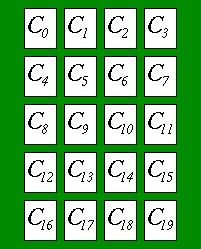
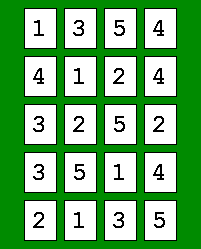
As the proverb says,
"Patience is bitter, but its fruit is sweet."
Writing programs within the limited time may impose some patience on you, but you enjoy it and win the contest, we hope.
The word "patience" has the meaning of perseverance, but it has another meaning in card games. Card games for one player are called "patience" in the UK and "solitaire" in the US.
Let's play a patience in this problem.
In this card game, you use only twenty cards whose face values are positive and less than or equal to 5 (Ace's value is 1 as usual). Just four cards are available for each face value.
At the beginning, the twenty cards are laid in five rows by four columns (See Figure 1). All the cards are dealt face up.
An example of the initial layout is shown in Figure 2.
 |
 |
| Figure 1: Initial layout | Figure 2: Example of the initial layout |
The purpose of the game is to remove as many cards as possible by repeatedly removing a pair of neighboring cards of the same face value. Let us call such a pair a matching pair.
The phrase "a pair of neighboring cards" means a pair of cards which are adjacent to each other. For example, in Figure 1, C6 is adjacent to any of the following eight cards:
C1, C2, C3, C5, C7, C9, C10 and C11. In contrast, C3 is adjacent to only the following three cards: C2, C6 and C7.
Every time you remove a pair, you must rearrange the remaining cards
as compact as possible.
To put it concretely, each remaining card Ci
must be examined in turn
in its subscript order to be shifted to the uppermost-leftmost
space.
How to play:
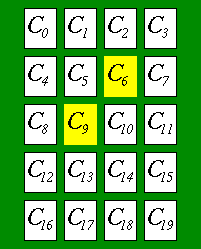 |
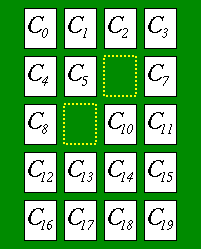 |
| Figure 3: A matching pair found | Figure 4: Remove the matching pair |
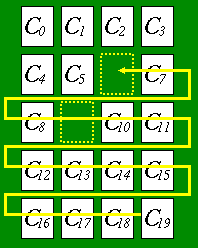 |
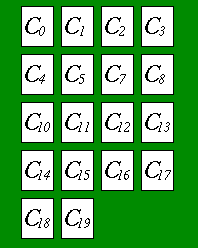 |
| Figure 5: Shift the remaining cards | Figure 6: Rearranged layout |
If you can remove all the twenty cards, you win the game and your penalty is 0. If you leave some cards, you lose the game and your penalty is the number of the remaining cards.
Whenever you find multiple matching pairs, you must choose one pair out of them as in the step 2 of the above procedure. The result of the game depends on these choices.
Your job is to write a program which answers the minimal penalty for each initial layout.
The input consists of multiple card layouts. The input is given in the following format.
N
Layout0
Layout1
...
LayoutN-1
N is the number of card layouts. Each card layout gives the initial state of a game. A card layout is given in the following format.
C0 C1 C2 C3
C4 C5 C6 C7
C8 C9 C10 C11
C12 C13 C14 C15
C16 C17 C18 C19
Ci (0 <= i <= 19) is an integer from 1 to 5 which represents the face value of the card.
For every initial card layout, the minimal penalty should be output, each in a separate line.
4 1 4 5 2 3 1 4 3 5 4 2 2 4 5 2 3 1 1 3 5 5 1 5 1 4 5 3 2 3 2 1 4 1 4 5 3 2 3 4 2 1 2 1 2 5 4 5 4 2 1 2 1 3 5 3 4 3 3 5 4 4 2 3 1 2 5 3 1 3 5 4 2 1 5 4 1 4 5 3 2
0 4 12 0